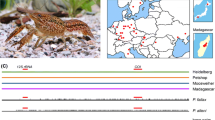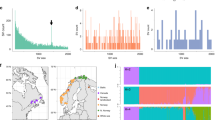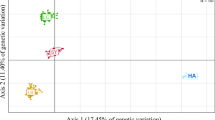Abstract
Background
The Siamese fighting fish (Betta splendens, also known as the betta) is well known in aquarium markets, and also presents an exciting new research model for studying parental care, aggressive behavior, and cryptically diverse pigmentation. However, concentrated efforts are required, both in the context of conservation biology and in its genetics, to address the problems of ongoing outbreeding depression, loss of biodiversity, and lack of scientific biological information.
Objective
The evolutionary dynamics of the betta must be better understood at the genomic scale in order to resolve the phylogenetic status of unrecognized species, develop molecular markers to study variation in traits, and identify interesting sets of genes encoding various bioresource functions.
Methods
The recent revolution in multi-omics approaches such as genomics, transcriptomics, epigenomics, and proteomics has uncovered genetic diversity and gained insights into many aspects of betta bioresources.
Results
Here, we present current research and future plans in an ongoing megaproject to characterize the betta genome as de novo assemblies, genes and repeat annotations, generating data to study diverse biological phenomena. We highlight key questions that require answers and propose new directions and recommendations to develop bioresource management to protect and enhance the betta genus.
Conclusion
Successful accomplishment of these plans will allow the creation of a reference annotated genome and provide valuable information at the molecular level that can be utilized to sustain biodiversity and eco-management of the betta to improve breeding programs for future biomedical research.




Similar content being viewed by others
References
Agca Y (2012) Genome resource banking of biomedically important laboratory animals. Theriogenology 78:1653–1665. https://doi.org/10.1016/j.theriogenology.2012.08.012
Ahmad SF et al (2020) Next-generation sequencing yields complete mitochondrial genome assembly of peaceful betta fish, Betta imbellis (Teleostei: Osphronemidae). Mitochond DNA B Resour. https://doi.org/10.1080/23802359.2020.1841582
Alyan S (2007) Aggressive behaviour in Betta splendens as a bio-indicator of freshwater pollution. Fresenius Environ Bull 16:176–181
Andrews C (1990) The ornamental fish trade and fish conservation. J Fish Biol 37:53–59
Ansah YB, Frimpong EA, Hallerman EM (2014) Genetically-improved tilapia strains in Africa: potential benefits and negative impacts. Sustainability 6:3697–3721. https://doi.org/10.3390/su6063697
Beer SD, Cornett S, Austerman P, Trometer B, Hoffman T, Bartron ML (2019) Genetic diversity, admixture, and hatchery influence in Brook Trout (Salvelinus fontinalis) throughout western New York State. Ecol Evol 9:7455–7479. https://doi.org/10.1002/ece3.5237
Bizuayehu TT, Babiak I (2014) MicroRNA in teleost fish. Genome Biol Evol 6:1911–1937. https://doi.org/10.1093/gbe/evu151
Blumer LS (1979) Male parental care in ray-finned fishes. Q Rev Biol 54:149–161
Blumer LS (1982) A bibliography and categorization of bony fishes exhibiting parental care. Zool J Linn Soc 76:1–22
Braddock JC, Braddock ZI (1995) Aggressive behavior among females of the Siamese fighting fish, Betta splendens. Physiol Zool 28:152–172. https://doi.org/10.1086/physzool.28.2.30163682
Britz R, Cambray JA (2001) Structure of egg surfaces and attachment organs in anabantoids. Ichthyol Explor Freshw 12:267–288
Carlson RL, Wainwright PC (2010) The ecological morphology of darter fishes (Percidae: Etheostomatinae). Biol J Linn Soc 100:30–45. https://doi.org/10.1111/j.1095-8312.2010.01417.x
Chailertrit V, Swatdipong A, Peyachoknagul S, Salaenoi J, Srikulnath K (2014) Isolation and characterization of novel microsatellite markers from Siamese fighting fish (Betta splendens, Osphronemidae, Anabantoidei) and their transferability to related species, B. smaragdina and B. imbellis. Genet Mol Res 13:7157–7162. https://doi.org/10.4238/2014
Chen SL, Tian YS (2005) Cryopreservation of flounder (Paralichthys olivaceus) embryos by vitrification. Theriogenology 63:1207–1219. https://doi.org/10.1016/j.theriogenology.2004.06.007
Coward K, Bromage N, Hibbitt O, Parrington J (2002) Gamete physiology, fertilization and egg activation in teleost fish. Rev Fish Biol Fisher 12:33–58. https://doi.org/10.1023/A:1022613404123
Crollius HR, Weissenbach J (2005) Fish genomics and biology. Genome Res 15:1675–1682. https://doi.org/10.1101/gr.3735805
da Silva SP, Cançado CR, Lattal KA (2014) Resurgence in Siamese fighting fish, Betta splendens. Behav Process 103:315–319. https://doi.org/10.1016/j.beproc.2014.01.004
Daya A, Donaka R, Karasik D (2020) Zebrafish models of sarcopenia. Dis Models Mech 13:dmm042689. https://doi.org/10.1242/dmm.042689
Deakin JE et al (2019) Chromosomics: bridging the gap between genomes and chromosomes. Genes 10:627. https://doi.org/10.3390/genes10080627
Debnath M, Prasad GBKS, Bisen PS (2010) Omics technology. In: Molecular diagnostics: promises and possibilities. Dordrech Heidelberg, London
Delgado-Vargas F, Jiménez AR, Paredes-López O (2000) Natural pigments: carotenoids, anthocyanins, and betalains–characteristics, biosynthesis, processing, and stability. Crit Rev Food Sci Nutr 40:173–289. https://doi.org/10.1080/10408690091189257
Department of Fisheries (2019) Fisheries single window data system. Fish Quarantine and Inspection Division, Department of Fisheries, Bangkok
Edashige K, Valdez DM Jr, Hara T, Saida N, Seki S, Kasai M (2006) Japanese flounder (Paralichthys olivaceus) embryos are difficult to cryopreserve by vitrification. Cryobiology 53:96–106. https://doi.org/10.1016/j.cryobiol.2006.04.002
Fan G et al (2018) Chromosome-level reference genome of the Siamese fighting fish Betta splendens, a model species for the study of aggression. Gigascience 7:giy087. https://doi.org/10.1093/gigascience/giy087
Fontana F, Chiarelli B, Rossi A (1970) Some new data on the number of chromosomes of teleost fish obtained by means of tissue culture in vitro. Experientia 26:1021. https://doi.org/10.1007/BF02114172
Gorman KF, Pohl K, Ali K, Bandwait K, Breden F (2012) Model teleosts for the study of idiopathic-type spinal curvatures: potential biomedical applications. J Appl Ichthyol 28:353–359. https://doi.org/10.1111/j.1439-0426.2012.01982.x
Griffin G (2005) Bettas in Peril: the Mahachai situation. IBC SMP, species complex management program. Retrieved July 4, 2009. http://smp.ibcbettas.org/articles/bettas_in_peril_Mahachai_griffin.html/
Gross MR, Sargent RC (1985) The evolution of male and female parental care in fishes. Am Zool 25:807–822
Harrisson KA et al (2014) Using genomics to characterize evolutionary potential for conservation of wild populations. Evol Appl 7:1008–1025. https://doi.org/10.1111/eva.12149
Hedges SB, Kumar S (2009) The timetree of life. Oxford University Press, Oxford
Herrero J et al (2016) Ensembl comparative genomics resources. Database (Oxford) 2016:bav096. https://doi.org/10.1093/database/bav096
Howe K et al (2013) The zebrafish reference genome sequence and its relationship to the human genome. Nature 496:498–503. https://doi.org/10.1038/nature12111
Jakobsen SK et al (2018) Helostoma temminkii, whole genome shotgun sequencing project, OMLM00000000. Submitted (01-MAR-2018) CEES, University of Oslo, Blindernveien 31, NO-3016, Oslo, Norway
Kasahara M et al (2007) The medaka draft genome and insights into vertebrate genome evolution. Nature 447:714–719. https://doi.org/10.1038/nature05846
Klasberg S, Bitard-Feildel T, Mallet L (2016) Computational identification of novel genes: current and future perspectives. Bioinform Biol Insights 10:121–131. https://doi.org/10.4137/BBI.S39950
Kowasupat C (2012) Betta siamorientalis, a new species of bubble-nest building fighting fish (Teleostei: Osphronemidae) from Eastern Thailand
Kramer B, van der Bank FH, Wink M, Flint N, Sauer-Giirth H (2003) Evidence for parapatric speciation in the Mormyrid fish, Pollimyrus castelnaui (Boulenger, 1911), from the Okavango-Upper Zambezi river systems: P. marianne sp. nov., defined by electric organ discharges, morphology and genetics. Environ Biol Fish 67:47–70. https://doi.org/10.1023/A:1024448918070
Lorin T, Brunet FG, Laudet V, Volff JN (2018) Teleost fish-specific preferential retention of pigmentation gene-containing families after whole genome duplications in vertebrates. G3 (Bethesda) 8:1795–1806. https://doi.org/10.1534/g3.118.200201
Luo DJ, Hu W, Chen SP, Zhu ZY (2011) Critical developmental stages for the efficiency of somatic cell nuclear transfer in zebrafish. Int J Biol Sci 7:476–486. https://doi.org/10.7150/ijbs.7.476
Mazur P, Leibo SP, Seidel GE Jr (2008) Cryopreservation of the germplasm of animals used in biological and medical research: importance, impact, status, and future directions. Biol Reprod 78:2–12. https://doi.org/10.1095/biolreprod.107.064113
Monvises A, Nuangsaeng B, Sriwattanarothai N, Panijpan B (2009) The Siamese fighting fish: well-known generally but little-known scientifically. ScienceAsia 35:8–16. https://doi.org/10.2306/scienceasia1513-1874.2009.35.008
Na-Ayudhya P (2001) Secret recipes for raising and propagating Siamese fighting fish [In Thai]. Naew Kasetagum Publishers, Bangkok
Natarajan R, Subrahmanyam K (1974) A karyotype study of some teleosts from portonovo waters. Proc ind Acad Sci 79:173–196. https://doi.org/10.1007/BF03045464
National Center for Biotechnology Information (NCBI) [Internet]. Bethesda (MD): National Library of Medicine (US), National Center for Biotechnology Information; [1988]—[cited 2020 June 06]. https://www.ncbi.nlm.nih.gov/
Near TJ et al (2011) Phylogeny and temporal diversification of darters (Percidae: Etheostomatinae). Syst Biol 60:565–595. https://doi.org/10.1093/sysbio/syr052
Niesenbaum RA (2019) The integration of conservation, biodiversity, and sustainability. Sustainability 11:4676. https://doi.org/10.3390/su11174676
Panijpan B et al (2014) Southeast Asian mouth-brooding Betta fighting fish (Teleostei: Perciformes) species and their phylogenetic relationships based on mitochondrial COI and nuclear ITS1 DNA sequences and analyses. Meta Gene 2:862–879. https://doi.org/10.1016/j.mgene.2014.10.007
Patino R, Takashima F, Gonads K, Takashima F, Hibiya T (eds) (1995) Atlas of fish histology, normal and pathological features, Tokyo, pp 128–153
Peuß R, Zakibe Z, Krishnan J, Merryman MS, Baumann DP, Rohner N (2019) Gamete collection and in vitro fertilization of Astyanax mexicanus. J Vis Exp. https://doi.org/10.3791/59334
Pitcher TJ (2012) The behaviour of teleost fishes. Japan, Springer Science & Business Media, p 553
Pomeroy R, Bravo-Ureta BE, Solis D, Johnston RJ (2008) Bioeconomic modelling and salmon aquaculture: an overview of the literature. Int J Environ Poll 33:485–500
Ponjarat J et al (2019) Complete mitochondrial genome of two mouthbrooding fighting fishes, Betta apollon and B. simplex (Teleostei: Osphronemidae). Mitochond DNA Part B 4:672–674
Prakhongcheep O, Muangmai N, Peyachoknagul S, Srikulnath K (2018) Complete mitochondrial genome of mouthbrooding fighting fish (Betta pi) compared with bubble nesting fighting fish (B. splendens). Mitochond DNA B 3:6–8. https://doi.org/10.1080/23802359.2017.1413294
Ramos A, Gonçalves D (2019) Artificial selection for male winners in the Siamese fighting fish Betta splendens correlates with high female aggression. Front Zool 16:34. https://doi.org/10.1186/s12983-019-0333-x
Ravi V, Venkatesh B (2018) The divergent genomes of teleosts. Annu Rev Anim Biosci 6:47–68. https://doi.org/10.1146/annurev-animal-030117-014821
Rice WR (1992) Sexually antagonistic genes: experimental evidence. Science 256:1436–1439
Rüber L, Britz R, Tan HH, Ng PK, Zardoya R (2004) Evolution of mouthbrooding and life-history correlates in the fighting fish genus Betta. Evolution 58:799–813. https://doi.org/10.1111/j.0014-3820.2004.tb00413.x
Rüber L, Britz R, Zardoya R (2006) Molecular phylogenetics and evolutionary diversification of labyrinth fishes (Perciformes: Anabantoidei). Syst Biol 55:374–397. https://doi.org/10.1080/10635150500541664
Sacerdot C, Louis A, Bon C, Berthelot C, Roest Crollius H (2018) Chromosome evolution at the origin of the ancestral vertebrate genome. Genome Biol 19:166. https://doi.org/10.1186/s13059-018-1559-1
Saint-Pé K et al (2018) Genetic admixture between captive-bred and wild individuals affects patterns of dispersal in a brown trout (Salmo trutta) population. Conserv Genet. https://doi.org/10.1007/s10592-018-1095-2
San-Jose LM, Roulin A (2017) Genomics of coloration in natural animal populations. Philos Trans R Soc Lond B Biol Sci 372:20160337. https://doi.org/10.1098/rstb.2016.0337
Schmidt J (1996) Vergleichende Untersuchungen zum Fortpflanzungsverhalten der Betta-Arten (Belontiidae, Anabantoidei). Natur and Wissenschaft, Solingen
Shen Y, Yue G (2019) Current status of research on aquaculture genetics and genomics-information from ISGA 2018. Aquacult Fish 4:43–47. https://doi.org/10.1016/j.aaf.2018.11.001
Shine R (1978) Propagule size and parental care: the “safe harbor” hypothesis. J Theor Biol 75:417–424. https://doi.org/10.1016/0022-5193(78)90353-3
Simpson MJA (1968) The display of the Siamese fighting fish, Betta splendens. Anim Behav Monogr 1:i–viii, 1–73. https://doi.org/10.1016/S0066-1856(68)80001-9
Singchat W et al (2020) Complete mitochondrial genome of Mahachai betta, Betta mahachaiensis (Teleostei: Osphronemidae). Mitochond DNA B Resour 5:3077–3079
Song YN, Xiao GB, Li JT (2016) Complete mitochondrial genome of the Siamese fighting fish (Betta splendens). Mitochond DNA Part A 27:4580–4581. https://doi.org/10.3109/19401736.2015.1101573
Srikulnath K, Swatdipong A, Uno Y, Matsubara K, Peyachoknagul S, Matsuda Y (2011) Retroelement compartmentalization of Rex1, Rex3 and Rex6 in Siamese fighting fish genome. In: Proceedings of the 17th National Genetic Conference, Chiang Mai, Thailand
Srikulnath K, Thongpan A, Suputtitada S, Apisitwanich S (2012) New haplotype of the complete mitochondrial genome of Crocodylus siamensis and its species-specific DNA markers: distinguishing C. siamensis from C. porosus in Thailand. Mol Biol Rep 39:4709–4717. https://doi.org/10.1007/s11033-011-1263-7
Srikulnath K, Uno Y, Nishida C, Ota H, Matsuda Y (2015) Karyotype reorganization in the Hokou gecko (Gekko hokouensis, Gekkonidae): the process of microchromosome disappearance in Gekkota. PLoS One 10:e0134829. https://doi.org/10.1371/journal.pone.0134829
Sriwattanarothai N, Steinke D, Ruenwongsa P, Hanner R, Panijpan B (2010) Molecular and morphological evidence supports the species status of the Mahachai fighter Betta sp. Mahachai and reveals new species of Betta from Thailand. J Fish Biol 77:414–424. https://doi.org/10.1111/j.1095-8649.2010.02715.x
Strand J et al (2020) Biobanking in amphibian and reptilian conservation and management: opportunities and challenges. Conserv Genet Resour. https://doi.org/10.1007/s12686-020-01142-y
Sugimoto M (2002) Morphological color changes in fish: regulation of pigment cell density and morphology. Microsc Res Tech 58:496–503. https://doi.org/10.1002/jemt.10168
Suryamohan K et al (2020) The Indian cobra reference genome and transcriptome enables comprehensive identification of venom toxins. Nat Genet 52:106–117. https://doi.org/10.1038/s41588-019-0559-8
Tlusty M (2002) The benefits and risks of aquacultural production for the aquarium trade. Aquaculture 205:203–219. https://doi.org/10.1016/S0044-8486(01)00683-4
U.S. Fish and Wildlife Service (2019) Siamese fighting fish (Betta splendens) ecological risk screening summary, USA
Vasta GR, Ahmed H, Du S, Henrikson D (2004) Galectins in teleost fish: Zebrafish (Danio rerio) as a model species to address their biological roles in development and innate immunity. Glycoconj J 21:503–521. https://doi.org/10.1007/s10719-004-5541-7
Verbeek P, Iwamoto T, Murakami N (2008) Variable stress-responsiveness in wild type and domesticated fighting fish. Physiol Behav 93:83–88
Vierke J (1991) Brutpflegestrategien bei Belontiiden (Pisces, Anabantoidei). Bonn Zool Beitr 42:299–324
Villars TA (1983) Hormones and aggressive behavior in teleost fishes. In: Svare BB (ed) Hormones and aggressive behavior. Plenum Press, New York
Volff JN (2005) Genome evolution and biodiversity in teleost fish. Heredity 94:280–294. https://doi.org/10.1038/sj.hdy.6800635
Vu TD et al (2020) Behavioral and brain- transcriptomic synchronization between the two opponents of a fighting pair of the fish Betta splendens. PLoS Genet 16:e1008831
Watanabe S, Kuczaj SA (2013) Emotions of animals and humans. Springer, Japan, p 553
Witte K, Schmidt J (1992) Betta brownorum, a new species of anabantoids (Teleostei; Belontiidae) from Northwestern Borneo, with a key to the genus. Ichthyol Explor Freshw 2:305–330
World Economic Forum (2018) Harnessing the Fourth Industrial Revolution for Life on Land, Switzerland
Wright AE et al (2018) Male-biased gene expression resolves sexual conflict through the evolution of sex-specific genetic architecture. Evol Lett 2:52–61
Yoshizaki G, Lee S (2018) Production of live fish derived from frozen germ cells via germ cell transplantation. Stem Cell Res 29:103–110. https://doi.org/10.1016/j.scr.2018.03.015
Zhang XS, Zhao L, Hua TC, Zhu HY (1989) A study on the cryopreservation of common carp (Cyprinus carpio) embryos. Cryo-Letters 10:271–278
Zhang W et al (2019) Transcriptomic analysis of Anabas testudineus and its defensive mechanisms in response to persistent organic pollutants exposure. Sci Total Environ 669:621–630. https://doi.org/10.1016/j.scitotenv.2019.02.440
Acknowledgements
We thank the National Research Council of Thailand and Kasetsart University for supporting our research plan and grants. We thank the Plakad association, Thailand for providing information about Betta spp. in Thailand. We are grateful to Napavarn Noparatnaraporn from Kasetsart University, Soranuth Sirisuay from the Faculty of Fisheries, Kasetsart University, Sukumal Prukudom and Kannika Siripattarapravat from the Faculty of Veterinary Medicine, Kasetsart University for very kind suggestion and discussion.
Funding
This research was financially supported by a grant from the National Research Council of Thailand (NRCT/16/2563) (awarded to KS, WS, NL, NS, AS, KJ, TP, RP, NA, JC, PD, SD, and NM), the Center for Advanced Studies in Tropical Natural Resources, National Research University-Kasetsart University (awarded to KS), the Thailand Research Fund (nos. RSA6180075, PHD60I0014, and PHD60I0082) through a grant awarded to KS, WS, and AS, the Science Achievement Scholarship of Thailand (no. 5917400296) through a grant from the Office of the Higher Education Commission, Thailand (awarded to NL), a grant from the Graduate Scholarship Program of the Graduate School, Kasetsart University, Thailand (awarded to TP and KS), a Postdoctoral Researcher award at Kasetsart University (awarded to SFA and KS), and the Coordenação de Aperfeiçoamento de Pessoal de Nível Superior—Brasil (CAPES) (no. 88882.433287/2019-01) awarded to MJ.
Author information
Authors and Affiliations
Corresponding author
Additional information
Publisher's Note
Springer Nature remains neutral with regard to jurisdictional claims in published maps and institutional affiliations.
Rights and permissions
About this article
Cite this article
Srikulnath, K., Singchat, W., Laopichienpong, N. et al. Overview of the betta fish genome regarding species radiation, parental care, behavioral aggression, and pigmentation model relevant to humans. Genes Genom 43, 91–104 (2021). https://doi.org/10.1007/s13258-020-01027-2
Received:
Accepted:
Published:
Issue Date:
DOI: https://doi.org/10.1007/s13258-020-01027-2




